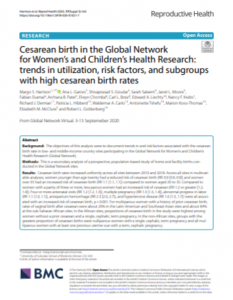
Background
The objectives of this analysis were to document trends in and risk factors associated with the cesarean birth rate in low- and middle-income country sites participating in the Global Network for Women’s and Children’s Health Research (Global Network).
Methods
This is a secondary analysis of a prospective, population-based study of home and facility births conducted in the Global Network sites.
Results
Cesarean birth rates increased uniformly across all sites between 2010 and 2018. Across all sites in multivariable analyses, women younger than age twenty had a reduced risk of cesarean birth (RR 0.9 [0.9, 0.9]) and women over 35 had an increased risk of cesarean birth (RR 1.1 [1.1, 1.1]) compared to women aged 20 to 35. Compared to women with a parity of three or more, less parous women had an increased risk of cesarean (RR 1.2 or greater [1.2, 1.4]). Four or more antenatal visits (RR 1.2 [1.2, 1.3]), multiple pregnancy (RR 1.3 [1.3, 1.4]), abnormal progress in labor (RR 1.1 [1.0, 1.1]), antepartum hemorrhage (RR 2.3 [2.0, 2.7]), and hypertensive disease (RR 1.6 [1.5, 1.7]) were all associated with an increased risk of cesarean birth, p < 0.001. For multiparous women with a history of prior cesarean birth, rates of vaginal birth after cesarean were about 20% in the Latin American and Southeast Asian sites and about 84% at the sub-Saharan African sites. In the African sites, proportions of cesarean birth in the study were highest among women without a prior cesarean and a single, cephalic, term pregnancy. In the non-African sites, groups with the greatest proportion of cesarean births were nulliparous women with a single, cephalic, term pregnancy and all multiparous women with at least one previous uterine scar with a term, cephalic pregnancy.